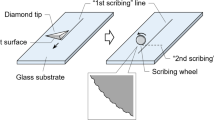Abstract
The wet processing of SU8 resist was modified in order to achieve a high-aspect ratio patterning with feature size of 100 nm. A final rinse in water, which makes a large contact angle on the resist (less wetting) was added to the procedure. This allowed considerable reduction of the capillary force, which is responsible for pattern distortions in three-dimensional (3D) lithography. 3D recording of high-aspect ratio (far=18) structures by holographic exposure using femtosecond pulses in SU8 resist was achieved using this modified development procedure. The thickness of the free-standing planes was approximately 100 nm. High fidelity of this recording method was confirmed by a Moiré pattern transfer into a developed SU8 pattern. In terms of focusing, the 100 nm feature size comprised 1/13-th of the diffraction limit. This modified development is applicable for wet processing when super-critical drying cannot be used.
Similar content being viewed by others
References
Deubel M, von Freyman G, Wegener M, Pereira S, Busch K, Soukulis CM (2004) Nature Mater 3:444
Juodkazis S, Mizeikis V, Seet KK, Miwa M, Misawa H (2005) Nanotechnology 16:846
Israelachvili JN (1992) Intermolecular and Surface Forces. Academic Press, London, 2nd ed
Namatsu H, Kurihara K, Nagase M, Iwadate K, Murase K (1995) Appl Phys Lett 66:2655
Ashby MF, Gibson LJ, Wegst U, Olive R (1995) Proc Roy Soc Lond A 450:123
McHugh MA, Krukonis VJ (1994) Supercritical Fluid Extraction. Butterworth-Heinemann, Boston, 2nd ed
Eckert CA, Knutson BL, Debendetti PG (1996) Nature 383:313
Weissberger A (ed) (1986) Organic Solvents. Physical Properties and Methods of Purification. John Wiley & Sons, Inc, New York, 4th ed
Kondo T, Matsuo S, Juodkazis S, Misawa H (2001) Appl Phys Lett 79:725
Kondo T, Matsuo S, Juodkazis S, Mizeikis V, Misawa H (2003) Appl Phys Lett 82:2758
Kondo T, Yamasaki K, Juodkazis S, Matsuo S, Mizeikis V, Misawa H (2004) Thin Solid Films 453–454:550
Tanaka T, Morigami M, Atoda N (1993) Jpn J Appl Phys 32:6059
Miwa M, Douoka K, Yoneyama S, Tuchitani S, Kosihmoto Y, Kaneko R (2005) In: A El-Fatatry (ed) MOEMS and Miniaturized Systems V. SPIE, Bellingham, WA, doi: 10.1117/12.589197, pp 6–13
Author information
Authors and Affiliations
Corresponding author
Additional information
PACS
81.05.-t; 81.07.-b; 81.16.-c; 81.40.-z; 81.65.-b
Rights and permissions
About this article
Cite this article
Kondo, T., Juodkazis, S. & Misawa, H. Reduction of capillary force for high-aspect ratio nanofabrication. Appl. Phys. A 81, 1583–1586 (2005). https://doi.org/10.1007/s00339-005-3337-7
Received:
Accepted:
Published:
Issue Date:
DOI: https://doi.org/10.1007/s00339-005-3337-7




